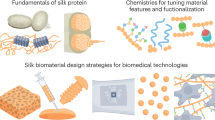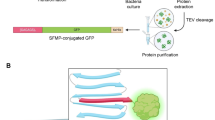Abstract
Silk fibroin (SF) is a natural protein polymer material approved by the US Food and Drug Administration for clinical use, such as for surgical sutures. In addition, SF has been fabricated and studied as a scaffold for tissue engineering and regenerative medicine. To append new functions to SF scaffolds and understand their in vivo behaviors, researchers have addressed modifications of SF scaffolds by using transgenic silkworm and peptide modification technologies. These modified SF scaffolds had on-target functions and showed their potential as a material for tissue engineering applications. This review summarizes the methodologies and characteristics of functionalized SF scaffolds.
This is a preview of subscription content, access via your institution
Access options
Subscribe to this journal
Receive 12 print issues and online access
$259.00 per year
only $21.58 per issue
Buy this article
- Purchase on Springer Link
- Instant access to full article PDF
Prices may be subject to local taxes which are calculated during checkout





Similar content being viewed by others
References
Jewell M, Daunch W, Bengtson B, Mortarino E. The development of SERI® Surgical Scaffold, an engineered biological scaffold. Ann N Y Acad Sci. 2015;1358:44–55.
Rockwood DN, Preda RC, Yücel T, Wang X, Lovett ML, Kaplan DL. Materials fabrication from Bombyx mori silk fibroin. Nat Protoc. 2011;6:1612–31.
Holland C, Numata K, Rnjak-Kovacina J, Seib FP. The biomedical use of silk: past, present, future. Adv Healthc Mater. 2019;8:1800465.
Leal-Egaña A, Scheibel T. Interactions of cells with silk surfaces. J Mater Chem. 2012;22:14330–6.
Kambe Y, Mizoguchi Y, Kuwahara K, Nakaoki T, Hirano Y, Yamaoka T. Beta-sheet content significantly correlates with the biodegradation time of silk fibroin hydrogels showing a wide range of compressive modulus. Polym Degrad Stab. 2020;179:109240.
Tamura T, Thibert C, Royer C, Kanda T, Eappen A, Kamba M, et al. Germline transformation of the silkworm Bombyx mori L. using a piggyBac transposon-derived vector. Nat Biotechnol. 2000;18:81–84.
Sasaki T, Noda H. Studies on silk fibroin of Bombyx mori directly extracted from the silk gland: I. Molecular weight determination in guanidine hydrochloride or urea solutions. Biochim Biophys Acta. 1973;310:76–90.
Yamaguchi K, Kikuchi Y, Takagi T, Kikuchi A, Oyama F, Shimura K, et al. Primary structure of the silk fibroin light chain determined by cDNA sequencing and peptide analysis. J Mol Biol. 1989;210:127–39.
Tanaka K, Inoue S, Mizuno S. hydrophobic interaction of P25, containing Asn-linked oligosaccharide chains, with the H-L complex of silk fibroin produced by Bombyx mori. Insect Biochem Mol Biol. 1999;29:269–76.
Inoue S, Tanaka K, Arisaka F, Kimura S, Ohtomo K, Mizuno S. Silk fibroin of Bombyx mori is secreted, assembling a high molecular mass elementary unit consisting of H-chain, L-chain, and P25, with a 6:6:1 molar ratio. J Biol Chem. 2000;275:40517–28.
Kambe Y, Yamamoto K, Katsura K, Tamada Y, Tomita N. Effects of RGDS sequence genetically interfused in the silk fibroin light chain protein on chondrocyte adhesion and cartilage synthesis. Biomaterials. 2010;31:7503–11.
Rouslahti E, Pierschbacher MD. Arg-Gly-Asp: a versatile cell recognition signal. Cell. 1986;44:517–8.
Kambe Y, Takeda Y, Yamamoto K, Katsura K, Tamada Y, Tomita N. Effect of RGDS-expressing fibroin dose on initial adhesive force of a single chondrocyte. Biomed Mater Eng. 2010;20:309–16.
Tamada Y. New process to form a silk fibroin porous 3-D structure. Biomacromolecules. 2005;6:3100–6.
Westall FC, Rubin R, Gospodarowicz D. Brain-derived fibroblast growth factor: a study of its inactivation. Life Sci. 1983;33:2425–9.
Caccia P, Nitti G, Cletini O, Pucci P, Ruoppolo M, Bertolero F, et al. Stabilization of recombinant human basic fibroblast growth factor by chemical modification of cysteine residues. Eur J Biochem. 1992;204:649–55.
Estapé D, van den Heuvel J, Rinas U. Susceptibility toward intramolecular disulfide-bond formation affects conformational stability and folding of human basic fibroblast growth factor. Biochem J. 1998;335:343–9.
Cuevasa P, Burgosa J, Baird A. Basic fibroblast growth factor (FGF) promotes cartilage repair in vivo. Biochem Biophys Res Commun. 1988;156:611–8.
Kambe Y, Kojima K, Tamada Y, Tomita N, Kameda T. Silk fibroin sponges with cell growth-promoting activity induced by genetically fused basic fibroblast growth factor. J Biomed Mater Res Part A. 2016;104:82–93.
Kambe Y, Tamada Y, Kameda T. Effects of phosphate, tris, HEPES, or MOPS buffers on the formation of silk fibroin sponges. J Silk Sci Technol Jpn. 2018;26:21–30.
Tomita M. Transgenic silkworms that weave recombinant proteins into silk cocoons. Biotechnol Lett. 2011;33:645–54.
Kambe Y, Murakoshi A, Urakawa H, Kimura Y, Yamaoka T. Vascular induction and cell infiltration into peptide-modified bioactive silk fibroin hydrogels. J Mater Chem B. 2017;5:7557–71.
Wang X, Kluge JA, Leisk GG, Kaplan DL. Sonication-induced gelation of silk fibroin for cell encapsulation. Biomaterials. 2008;29:1054–64.
Yucel T, Cebe P, Kaplan DL. Vortex-induced injectable silk fibroin hydrogels. Biophys J. 2009;97:2044–50.
Matsumoto A, Chen J, Collette AL, Kim UJ, Altman GH, Cebe P, et al. Mechanisms of silk fibroin sol-gel transitions. J Phys Chem B. 2006;110:21630–8.
Zhang W, Wang X, Wang S, Zhao J, Xu L, Zhu C, et al. The use of injectable sonication-induced silk hydrogel for VEGF165 and BMP-2 delivery for elevation o the maxillary sinus floor. Biomaterials. 2011;32:9415–24.
Kambe Y, Yamaoka T. Biodegradation of injectable silk fibroin hydrogel prevents negative left ventricular remodeling after myocardial infarction. Biomater Sci. 2019;7:4153–65.
Rane AA, Christman KL. Biomaterials for the treatment of myocardial infarction. A 5-year update. J Am Coll Cardiol 2011;58:2615–29.
Zhu Y, Matsumura Y, Wagner WR. Ventricular wall biomaterial injection therapy after myocardial infarction: advances in material design, mechanistic insight and early clinical experiences. Biomaterials. 2017;129:37–53.
Tous E, Ifkovitz JI, Koomalsingh KJ, Shuto T, Soeda T, Kondo N, et al. Influence of injectable hyaluronic acid hydrogel degradation behavior on infarction-induced ventricular remodeling. Biomacromolecules. 2011;12:4127–35.
Wang Y, Rudym DD, Walsh A, Abrahamsen L, Kim HJ, Kim HS, et al. In vivo degradation of three-dimensional silk fibroin scaffolds. Biomaterials. 2008;29:3415–28.
Kambe Y, Yamaoka T. Initial immune response to a FRET-based MMP sensor-immobilized silk fibroin hydrogel in vivo. Acta Biomater. 2021;130:199–210.
Power G, Moore Z, O′Connor T. Measurement of pH, exudate composition and temperature in wound healing: a systematic review. J Wound Care. 2017;26:381–97.
Brown J, Lu CL, Coburn J, Kaplan DL. Impact of silk biomaterial structure on proteolysis. Acta Biomater. 2015;11:212–21.
Teramoto H, Kojima K. Production of Bombyx mori silk fibroin incorporated with unnatural amino acids. Biomacromolecules. 2014;15:2682–90.
Chantawong P, Tanaka T, Uemura A, Shimada K, Higuchi A, Tajiri H, et al. Silk fibroin-Pellethane® cardiovascular patches: effect of silk fibroin concentration on vascular remodeling in rat model. J Mater Sci: Mater Med. 2017;28:191.
Hong H, Seo YB, Kim DY, Lee JS, Lee YJ, Lee H, et al. Digital light processing 3D printed silk fibroin hydrogel for cartilage tissue engineering. Biomaterials. 2020;232:119679.
Acknowledgements
This work was financially supported by the Japan Society for the Promotion of Science Grant-in-Aid for Scientific Research (B) (grant no. 20H04509).
Author information
Authors and Affiliations
Contributions
Yusuke Kambe: Conceptualization, Data curation, Formal analysis, Funding acquisition, Investigation, Methodology, Project administration, Supervision, Validation, Writing-original draft, Writing-review & editing.
Corresponding author
Ethics declarations
Conflict of interest
The author declares no competing interests.
Additional information
Publisher’s note Springer Nature remains neutral with regard to jurisdictional claims in published maps and institutional affiliations.
Rights and permissions
About this article
Cite this article
Kambe, Y. Functionalization of silk fibroin-based biomaterials for tissue engineering. Polym J 53, 1345–1351 (2021). https://doi.org/10.1038/s41428-021-00536-5
Received:
Revised:
Accepted:
Published:
Issue Date:
DOI: https://doi.org/10.1038/s41428-021-00536-5
This article is cited by
-
Protein-modified nanomaterials: emerging trends in skin wound healing
Discover Nano (2023)
-
Harnessing cell reprogramming for cardiac biological pacing
Journal of Biomedical Science (2023)
-
Biphasic scaffolds of polyvinyl alcohol with silk fibroin for oral and maxillofacial surgery based on mimicking materials design: fabrication, characterization, properties
Journal of Materials Science (2022)



